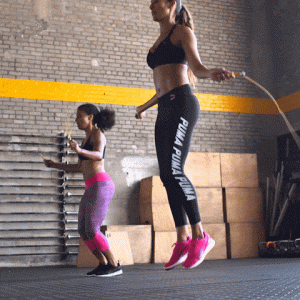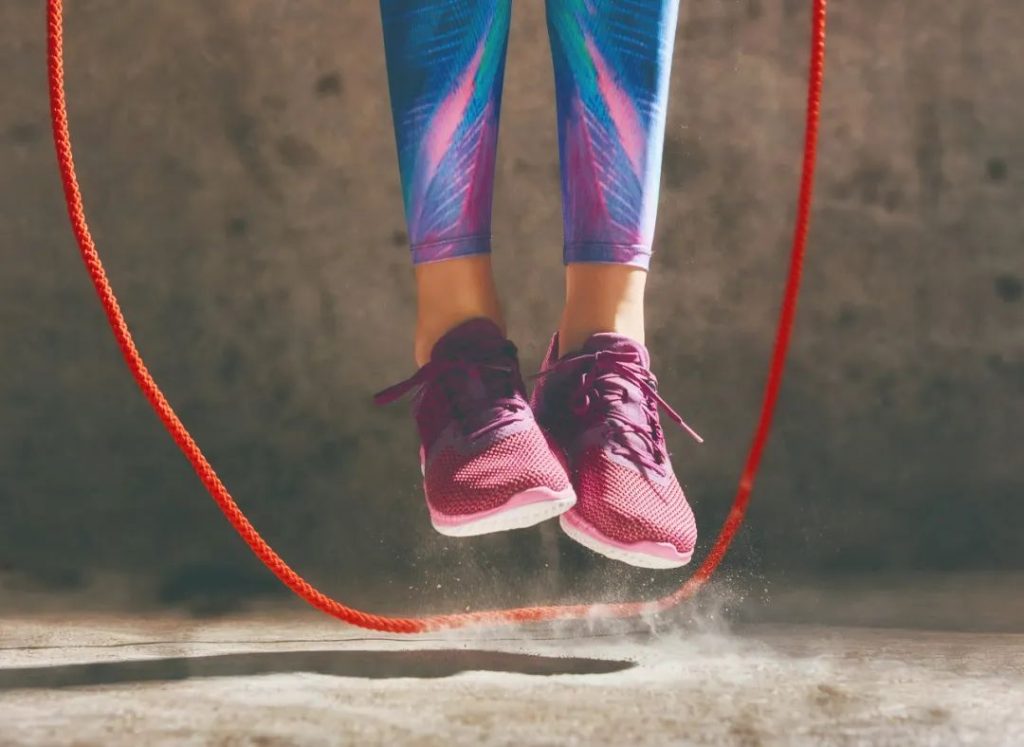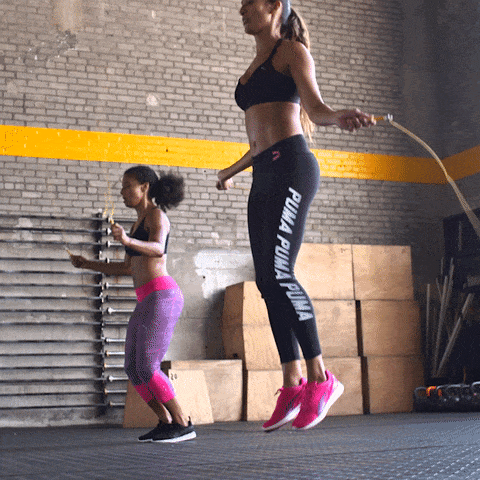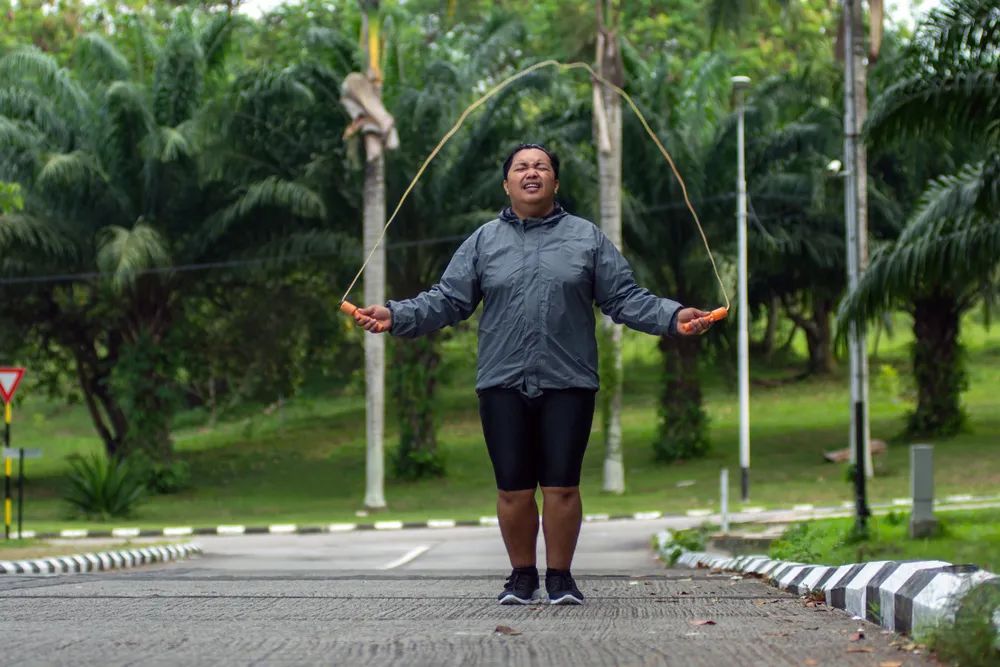
Many people change their forms of exercise due to the novel coronavirus epidemic.
It’s not convenient to go gym, wearing mask outdoor is also a trouble. So rope jumping, which demands 0 basis and can be practised at home becomes a nationwide physical exercise.

While it comes along various rumors. 「One can lose weight 15 kg by jumping rope for a month」「People can jump rope even without any rope」「 Legs will get fatter by jumping rope」……But are those really true?
So let’s check out 10 facts about rope jumping.
01. Jumping rope burns up a lot calories
Rope jumping is a kind of exercise which it takes a little time while burns a lot calories.
Let’s count the calories that jumping rope burns and jogging.
1 km jogging burns about 1 kcal/kg.
7 × 0.3 × 65 × 1 = 136.5 kcal
An adult weighing 65kg jogs 20 minutes by 7km/h. It will burn
7 × 0.3 × 65 × 1 = 136.5 kcal
Fast jumping rope by 150 times/min, it will burn 16 kcal/min calories.
16 × 10 = 160 kcal
Jumping 10 minutes will burn about
16 × 10 = 160 kcal
Jumping rope with medium speed by 70-80 times/min, it will burn 10 kcal/min.
10 × 10 = 100 kcal
jumping 10 minutes will burn about 10 × 10 = 100 kcal
Just counting the burning calories,
jumping a rope fast for 10 minutes will cost you as much energy as jogging for 23 minutes.
10 minutes of medium-speed rope jumping is equivalent to about 15 minutes of jogging
Comparing to jogging, not that much exaggerated that「10 minutes jumping = 30 minutes lopping」, while rope jumping is indeed a high efficiency exercise.
02. jumping 70-80 times/ minute causes good weight loss effect.
Though simply any move burns calories, the medium exercise has better fat burning effect.
70-80 times/min jumping is satisfying
jumping 30 minutes every day by 70-80 times/min, it not only fits most common people physically, but also causes nice weight loss effect. Of course, if you are a starter, you can also jump for like 2 minutes and then rest for 2 minutes, on and off to finish all 30 minutes exercise.
If you have nice physical ability, want a greater challenge, you can try intermittent jumping: jump 2 minutes by 150 times/min, and rest 30-60 seconds, repeat jump-rest cycle by 15 times. It have great effect, too.

03.jumping rope for a month a person can lose weight 1.5 kg.
Rope jumping is indeed a great weight loss exercise. But it is an over
Exaggerated rumor that one could lose weight 15kg by jumping for a month.
Let’s count calories again,
It needs to burn 7700 kcal energy to lose 1 kg fat.
If just jumping 30-40 minutes by 70-80 times/min without adjusting diet, it will burn 300-400 kcal energy.
It will burn 9000-12000 kcal energy if one jump everyday without any break. Ideally, one can lose 1.2-1.5kg fat if converting energy to fat.
But, do not be discouraged, 1.5 kg fat is a great number. It will have better effect if with keeping diet.
Moreover, it also helps you develop a good exercise habit. Cardiovascular function and muscle strength will be improved as well.
04. jumping rope helps leg slimming
People who worry legs would get fatter after jumping rope can take ease.
The key to muscle growth is to give excitement beyond its ability, but rope jumping is actually a take-off action that overcomes gravity, which is not difficult for the calf muscles.
jumping rope at a medium speed for 30 minutes, for ordinary people, such exercise intensity will not increase the muscle volume excessively. On the contrary , it firms them up and makes Achilles tendon of calf longer and slimmer visually. Accordingly, calf looks slimmer, too.
In addition, jumping rope in long terms will reduce whole body fat, calf included. It will make calf slimmer both visually and actually.
Some people feel that their calves become thicker just after jumping rope, which may be caused by long standing exercises and more blood pooling in the lower limbs. After exercise, do a relaxing stretch to help the blood flow back, and it will return normal status.

05. jumping rope needs warm-up and stretching.
Although rope jumping is simple and easy to operate. While in order to prevent physical injury, warm-up before the start and final stretching must be done.
Warming up can move the joints and muscles of the whole body and reduce the risk of muscle strain when jumping rope. It can also make the heart rate gradually slowly raise. The heart will not suddenly switch from a static state to an exercise state without buffer period, otherwise which will bring an excessive burden to the heart and lung function.
Proper leg stretching after exercise can help muscle relax and promote blood return. When jumping rope, every time you jump and land, your body will be impacted by the reaction force of the ground. Most of the impact will be buffered by the calf muscles, which will make the muscles become tighter and tighter during exercise.
06. Do not jump rope on hard ground such as cement floor and tiles ground.
Since jumping rope is so easy and convenient, many people are ready to start practicing at home with a rope, don’t!
jumping rope will produce impact after landing. If the ground is too hard, the body joints will not be well buffered, the knees will be easily injured, cause minor joint injuries. Calf pain and ankle pain may occur.
In order to protect the joints, it is best to jump rope on the elastic plastic floor, not on the concrete floor. If you can only jump on the concrete floor (such as at home), you can use a layer of elastic blanket to absorb shock.
In addition to paying attention to the ground, other protections should be done when jumping rope:
Shoes: It is best to choose sports shoes with cushioning and shock absorption devices, not in barefoot or wearing hard-soled shoes;
Posture: Slightly bend your knees and touch the forefoot first. Do not hit the ground with your heel.

07.Do not jumping on an empty stomach. It will cause hypoglycemia
jumping on an empty stomach is indeed more conducive to fat consumption, but it may be bad for your body.
Studies have shown that compared with exercise after a meal, the blood sugar content in the body is lower when exercise on an empty stomach. More fat is used for energy during exercise, and the fat burning effect is better. However, the blood sugar in the body is low when on an empty stomach, and jumping the rope will make the blood sugar content even more lower, which may cause dizziness or even fainting, etc., and it will also increase the cardiovascular burden. It ‘s not worthy to sacrifice the body healthy to lose weight.
The key to weight loss is to create an energy gap by controlling your diet and increasing exercise. When to exercise, it is not that important.
Rest for a period of time after a meal and then exercise. As long as the exercise time is long enough, the fat burning effect can be achieved close to that of exercise on an empty stomach . There is no need to pursue such exercise.
08. People with BMI over 25 are not suitable for jumping rope
Rope jumping is a typical jumping sport. People with heavier weights will bear more pressure on their knees when jumping, and they will easily hurt their knees.
For overweight people with a BMI over 25, it is recommended to swim to lose weight first, and then consider jumping rope after reducing the weight
BMI= Weight (kg)/ height squared (m²)
Similarly, there are some other people who are not suitable for jumping rope:
People with bad knee joints. Repeated jumping action with jumping rope will add another burden to the knee joint.
People with big breasts. When you jump rope, you will be more strongly attacked by gravity. The most direct feeling is pain… If you want to jump, you must wear sports underwear.
For people with basic diseases such as heart disease and high blood pressure, don’t jump rope rashly. It is best to follow the doctor’s advice to choose the exercise type and intensity.

09. It can not increase height by jumping rope for an adult.
The rumors that “jumping helps to grow taller” are both right and wrong.
It is possible for a teenager. A moderate rate jumping has some positive stimulation for bones development to increase the longitudinal growth and height of bones. jumping rope, playing basketball and etc, are all good jumping sports.
But for an adult whose epiphysis is already closed. It’s hard to have any change to longitude of the bones development. Naturally he won’t grow any taller.
So adult, just take the reality.
In addition, you can’t blindly use jumping rope to remove stones and treat fallopian tube blockage… It’s just exercise, don’t think too much.
10. jumping without rope, jumping in place, those exercise effect is not bad.
jumping without rope is also workable if you do not have one or simply feel bored about noise when jumping.
jumping rope consumes energy, mainly by using the whole body muscles to do the repetitive action of jumping in place. As long as the action itself does not change much, there will not be much difference in promoting cardiopulmonary function and fat burning effect.
Rope jumping only requires more coordination and fine control of the hands and feet, and does not affect too many muscle group activities.

If you always hit yourself with rope when jumping, just throw it away, one, two, three, four, and jump on the spot without a rope~
Comments